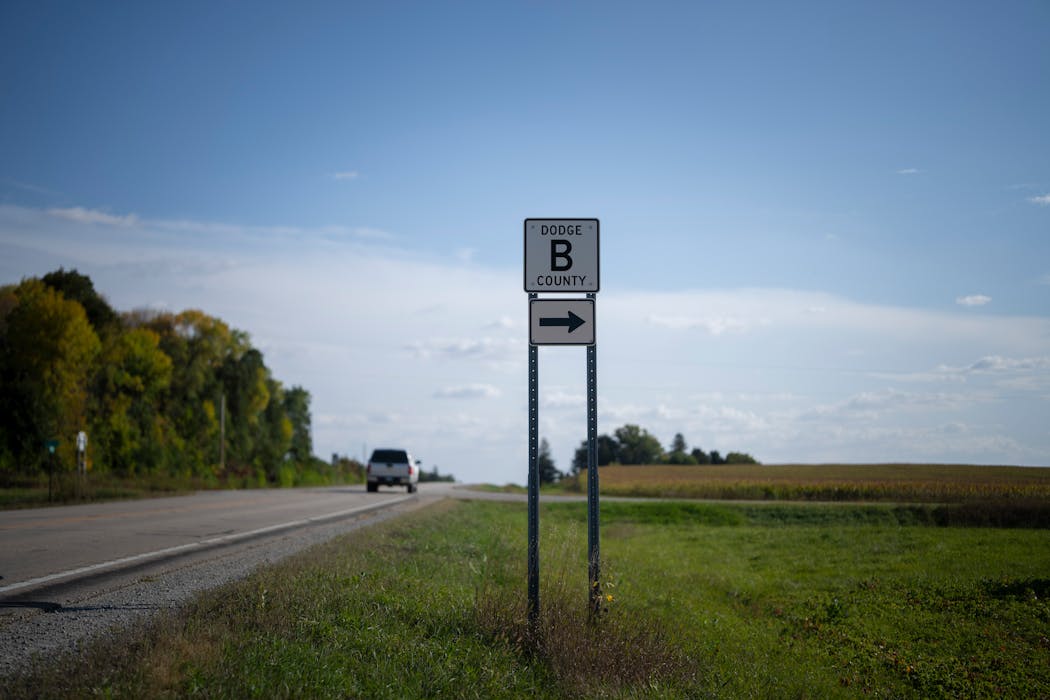Cancer ravaged Brian Bennerotte's body and those of many around him — his father, five brothers and his sister — as well as others along the gravel road where they grew up in southeast Minnesota.
The cancers just seemed to proliferate down the peaceful 2-mile stretch of County Road B in Dodge County, Bennerotte and his childhood friend Scott Glarner said. By their count, 13 people who lived on the road once lined with dairy farms near West Concord have contracted some type of cancer in the past few decades.
They know they have been exposed to a lot of farm chemicals in their lives, and a link to all the cancers will probably never be found. But Bennerotte said he keeps coming back to one thing: The high levels of nitrate in the water from their private wells, from farm fertilizers and manure.
"That's the only common denominator here," said Bennerotte, now 60.
Their "Cancer Road" story was first reported by Keith Schneider, chief correspondent at the Michigan-based nonprofit environmental news outlet Circle of Blue. The Dodge County water test results he obtained for 18 properties on or near County Road B showed a pattern of elevated nitrate in many of the private wells since the mid 1980s. The tests were voluntary or taken when a property sold. All but about a dozen of the 54 water tests showed elevated nitrate, with some results double the state and federal safety limit.
The types of cancers on the road aren't the types medical experts generally consider related and part of a cancer cluster. And while the International Agency for Research on Cancer deems nitrate to be a "probable carcinogen," only a few of the different cancers on County Road B have a researched association with nitrate-contaminated water. Those include non-Hodgkin's lymphoma, colon and kidney cancers. Some of the cancers have not been studied for a nitrate connection.
The rare public disclosure by the County Road B families highlights how far the understanding of health impacts of nitrate-contaminated water has expanded beyond blue baby syndrome, the rare and potentially fatal disease that drove the country's nitrate health limit of 10 milligram per liter of water officially set in 1992.
More recent research has shown drinking water with nitrate levels above 10 milligrams to be most strongly linked to colorectal cancer, thyroid disease and neural tube defects, according to Mary Ward, senior investigator at the National Cancer Institute.
A team at the College of Public Health at the University of Nebraska Medical Center, for example, is studying the role nitrate-contaminated water may be playing in Nebraska's high rate of childhood cancers. That kind of research doesn't appear to have happened in Minnesota although Minnesota's pediatric cancer rate is second-highest in the 12-state Midwest, just behind Nebraska, according to the Centers for Disease Control and Prevention.
Leslie Stayner, professor emeritus of epidemiology at the University of Illinois Chicago School of Public Health, analyzed data from Denmark and found evidence of an increasing risk of central nervous system cancers, low birth weight, preterm birth and some birth defects in children exposed prenatally to nitrates in water. Importantly, these adverse health effects were found among children who were prenatally exposed to levels below the country's current 10 milligram nitrate standard.
"There's a growing body of evidence that the current standards are not sufficiently protective," Stayner said.
The Minnesota Department of Health said this is the first they've heard of the County Road B concerns. Dodge County cancer rates haven't been higher than the state's rate in recent years and are currently lower, department spokesman Scott Smith said. Smith urged people with concerns to contact the state agency and check its Cancer and the Environment web page.
The agency recently set new health risk limits for more than 30 contaminants in Minnesota's groundwater — but not nitrate. That shocked Jean Wagenius, a retired longtime state lawmaker and Minneapolis DFLer who told the agency the nitrate standard should be lowered. In its reply, the Department of Health said it has "growing concern" about the health impacts but the science just isn't there to change the nitrate limit.
Dodge County is one of eight counties in southeast Minnesota that environmental groups have requested the U.S. Environmental Protection Agency take emergency action on under the Safe Drinking Water Act, saying local regulation has failed to reduce nitrate levels and is creating an "imminent and substantial endangerment" to human health.
Despite the fact that so much water in Minnesota is contaminated with nitrate, there is very little current state research into the health impacts. The Washington, D.C.-based Environmental Working Group has estimated that a half-million Minnesotans drink nitrate-tainted water.
A Mayo Clinic team recently studied data on nitrate-contaminated groundwater in southeast Minnesota counties — although not Dodge County. They didn't look at cancer, but found associations between nitrate and a range of childhood maladies such as chronic obstructive pulmonary disease and bronchiectasis, thyroid disorders, suicide and attention deficit disorders, according to their report this spring in the International Journal of Environmental Research and Public Health.
Bennerotte and Glarner want the nitrate limit lowered. State and local authorities need to take more action on potential health damages, they said.
"We can't stop what happened, but they can prevent something else," Bennerotte said.
Bennerotte lives in New Ulm now and works as a long-haul trucker. He recalled watching as a teen in 1980 when his father, Howard, was taken on a stretcher from their home on County Road B to the hospital. It was one of the most wrenching things he ever endured, he said. His father never came home. He died of kidney cancer.
Just three years later, Bennerotte was diagnosed with acute lymphoblastic lymphoma, with a tumor the size of a basketball wrapped around his heart and lungs. He was just 20. It was inoperable, and he endured 3½ years of chemotherapy and radiation. He still battles effects from the treatment that his Mayo doctor warned him about, he said, telling him, "What cured you today will kill you later on."
Cancer spread through the family. One of his brothers got prostate cancer. Another got colon cancer and died of Parkinson's disease. Another brother, who moved just across the road, died of multiple myeloma and kidney cancer, and his wife died of leiomyosarcoma, a cancer of smooth muscle tissue. Another brother died of complications from a type of blood cancer called myelodysplastic syndrome. His sister contracted MALT lymphoma in a tear duct, but survived. The only person who escaped cancer was their mother, Marie.
Prostate and pancreatic cancer aren't known to have associations with nitrate and some cancers in the family either haven't been studied for that or research was inconclusive.
There is no way to know the nitrate levels in the Bennerotte family's drinking well when they were growing up. A 1999 test of that well showed 19 milligrams per liter. Across the road, where his brother and wife moved and were later stricken with cancer, a 1990 test showed elevated nitrate around 8 milligrams per liter.
Others on the road fell ill, too. Neighbor Larry Serie died of pancreatic cancer in 1988, according to his daughter Lesa Serie. Another neighbor that Bennerotte and Glarner said had cancer declined to comment.
Glarner, 61, spent most of his life on the road, although he now lives in Dodge Center and works as the postmaster in nearby West Concord. From 2002-2011, multiple tests of the wells at two County Road B properties where Glarner lived showed nitrate generally around 8 to 12 milligrams per liter.
Glarner said he was diagnosed with non-Hodgkin's lymphoma in 2006. It's not curable, he said, but he's in remission and feels like a "ticking time bomb." His mother contracted breast cancer, although she survived it and died later of dementia, he said. Glarner said he was exposed to glyphosate in the herbicide RoundUp and received a payment, one of more than 100,000 RoundUp settlements.
Still, he said he is convinced that nitrate played a role. If nitrate exists in well water, his understanding is that there are likely other pesticides and herbicides in it, too — a farm water cocktail of chemicals: "Just kind of everything."
Such combinations need attention, said Paul Wotzka, a semi-retired hydrologist in Wabasha County who co-founded the Minnesota Well Owners Organization. A private well owner who drinks water contaminated with nitrate is probably also drinking 12-18 pesticides, at low levels, he said, pointing to a state Department of Agriculture report.
"That's what people should be studying," Wotzka said.
Bennerotte said, too, that nitrate was not the only chemical he was exposed to. His family used malathion in the barn for the flies on their cows, he said, and atrazine on the fields for weeds. Malathion is classified as a "probable carcinogen" by the International Agency for Research on Cancer. Atrazine, an endocrine disrupter, has been banned in the European Union.
It was all just part of their environment, he said: "We're just trying to figure this all out."

Want to share info with the Star Tribune? How to do it securely

'Safe recovery sites' would offer syringes, naloxone and more to people using drugs. The plan could be in peril.
New Minnesota GOP leaders seek peace with party's anti-establishment wing

Who is Republican Lisa Demuth, Minnesota's first House speaker of color?




